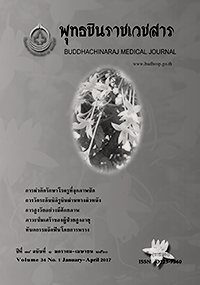การสูงวัยอย่างมีศักยภาพ : แนวคิดสู่การปฏิบัติ
คำสำคัญ:
การสูงวัยอย่างมีศักยภาพ, ผู้สูงอายุ, สุขภาพดี, มีส่วนร่วม, หลักประกันที่มั่นคงบทคัดย่อ
ประเทศไทยได้ก้าวเข้าสู่สังคมผู้สูงอายุและจะใช้เวลาอีก 20 ปีคือระหว่าง พ.ศ. 2548 ถึง พ.ศ. 2568 ในการก้าวสู่การเป็นสังคมผู้สูงอายุโดยสมบูรณ์ จึงจำเป็นต้องเตรียมวางแผนรองรับสำหรับประชากรผู้สูงอายุ องค์การอนามัยโลกได้เสนอแนวคิดการสูงวัยอย่างมีศักยภาพเป็นกระบวนการสร้างการมีสุขภาพดี การมีส่วนร่วม และการมีหลักประกันที่มั่นคง นำไปสู่คุณภาพชีวิตที่ดีของผู้สูงอายุ บทความนี้ได้นำเสนอรายละเอียดเกี่ยวกับแนวคิดการดูแลผู้สูงอายุในสังคมผู้สูงอายุ การดำเนินการเกี่ยวกับผู้สูงอายุในประเทศไทยและการนำแนวคิดการสูงวัยอย่างมีศักยภาพสู่การปฏิบัติ เพื่อสร้างความเข้าใจ สร้างทัศนคติเชิงบวกในการนำแนวคิดการสูงวัยอย่างมีศักยภาพสู่การปฏิบัติให้ผู้สูงอายุดำรงชีวิตอย่างมีคุณค่า มีความหมายต่อสังคม และร่วมเป็นพลังในการขับเคลื่อนสังคมและเศรษฐกิจของประเทศต่อไป
เอกสารอ้างอิง
2. World Health Organization. Proposed working definition of an older person in Africa for the MDS Project. 2017 [cited 2016 Dec 23]. Available from: http://www.who.int/healthinfo/survey/ageingdefnolder/en/
3. Foundation of Thai Gerontology Research and Development Institute (TGRI). Situation of the Thai elderly 2014. Bangkok: Amarin Printing & Publishing Public Company Limited [in Thai];2014.
4. United Nations. Department of Economic and Social Affairs, Population, Population Division. World Population Ageing 2013. New York:United Nations 2013.
5. Centers for Disease Control and Prevention. Public Health and Aging: Trends in Aging.[2003]. [cited 2016 Dec 12]. Available from: http://www.cdc.gov/mmwr/preview/mmwrhtml/mm5206a2.htm
6. Office of the National Economics and Social Development Board. Population Projections for Thailand 2010-2040. Bangkok: The National Economics and Social Development Board;2013.
7. Kinsella K, Phillips DR. Global aging: The challenge of success. Popul Bull 2005; 60(1):12-5.
8. Bureau of Health Promotion, Department of Health, Ministry of Public Health. Guide to healthy aging for health personnel. Bangkok:Ministry of Public Health; 2012.
9. Chan A. Singapore’s changing structure and the policy implications for financial security, employment, living arrangements and health care. [2001]. [cited 2016 Dec 12]. Available from: http://www.cpahq.org/cpahq/cpadocs/Singapores%20Changing%20Structure.pdf
10. Kaewanuchit C. Health determinants and social determinants of health under global and Thai health system. J Nurs Sci 2013;36(1):123-31.
11. Office of the Royal Society. Dictionary of the Royal Society. 2016 [cited 2016 Dec 10]. Available from: http://www.royin.go.th/dictionary/
12. World Health Organization. Active ageing a policy framework. 2002 [cited 2016 Dec 10]. Available from: URL:http://apps.who.int/iris/bitstream/10665/67215/1/WHO_NMH_NPH_02.8.pdf
13. Kespichayawattana J, Wiwatvanich S. Active ageing: A case study of elite Thai elderly. Bangkok: Thai Health Promotion Foundation;2006.
14. Sajjasophon R. Educational concepts for developing active aging in the elderly [in Thai]. Kasetsart J Soc Sci 2013;34:471-90.
15. The Thai Red Cross Society CU. Proceedings of The 3rd National Conference on Ageing and Elderly,[22-24 May 2015]; ASEAN Active Ageing Conference 2015:King Chulalongkorn Memorial Hospital Bangkok;2015.
16. Thanakwang K, Isaramala S, Hatthakit U. Development and psychometric testing of the active ageing scale for Thai adult. Clin Interv Ageing 2014;9:1211-21.
17. Saengprachaksakula S. The determinants of Thai active ageing level [in Thai]. J Soc Sci Human 2015;21(1):231-48.
18. Tantivipawin P. Towards the ASEAN economic community and the empowering of Thai elderly socio-economics. Romphruek J 2013;30(3):53-70.
19. Bowling A, Dieppe P. What is successful ageing and who should define it? BMJ 2005;331(7531):1548-51.
20. Sombat L, Yodphet S, Sakdaporn T. Productive ageing and socio- economic development in Thailand. Bangkok: Faculty of Social Administration, Thammasat University; 2011.
21. Soonthorndhada K, Khumsuwa K. Level and trend active ageing in Thai elderly Bangkok: National Population Conference; 2010.
22. Chansarn S. Active ageing of elderly people and its determinants: Empirical evidence from Thailand. Asia-Pacific Soc Sci Rev 2012; 12(1):1-21.
23. Phon-ngam P. Development of activities model for promoting healthy of aging in Thailand and Japan. Commerce Manage 2012;1(8):97-107.
24. Borisuth C, Jiradetprapai S, Yongyuan B, Phoopat P. The model of knowledge management for the development of active aging: A case study of tambol Pakpraek Municipality Changwat Karnchanaburia [in Thai]. Res Dev Human Soc Sci 2014;9(1): 26-35.
25. Human Information Develpment Department AD. Statement of Policy 2014.[cited 2016 Dec 10]. Available from: http://library2.parliament.go.th/giventake/statement.html
26. Sudsomboon S. Social Welfare for aging people in Thailand [in Thai]. J South Technol 2014;7(1):73-82.
27. Prachuabmoh V. Project on setting-up the system for monitoring and evaluation of the second national plan for older persons (2002-2021). Bangkok: College of Population Studies Chulalongkorn University; 2009.
28. National Health Security Office. Guide the longterm health care system for elderly with dependent: Fiscal Year 2559 [in Thai]. Nonthaburi: National Health Security Office;2016.
29. Heque MN. Active ageing level of older persons: Regional comparison in Thailand. J Aging Res 2016;2016:1-9.
30. Taweesin S, SunPhuwan M, Chuanwan S. Population and Asian Community: Challenge and opportunity. Nakorn Pathom: Institute for Population and Social Research, Mahidol;2013.
ดาวน์โหลด
เผยแพร่แล้ว
ฉบับ
ประเภทบทความ
สัญญาอนุญาต

อนุญาตภายใต้เงื่อนไข Creative Commons Attribution-NonCommercial-NoDerivatives 4.0 International License.






